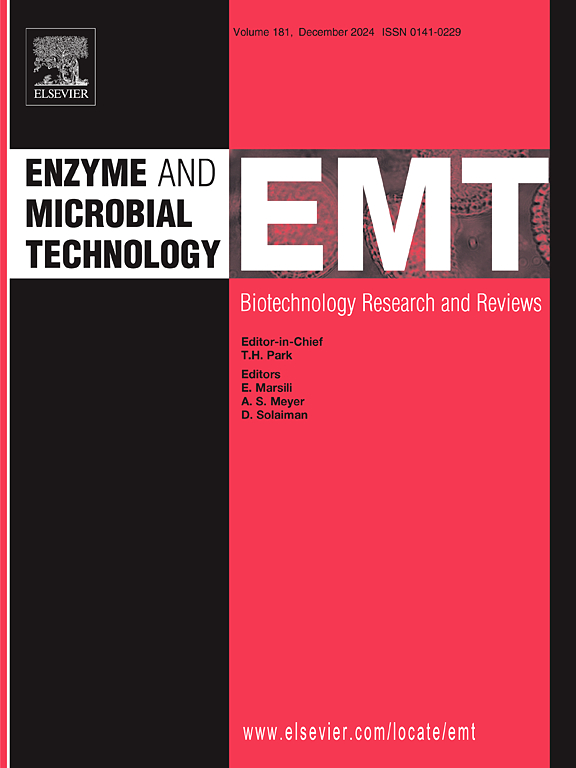Enhancement of the start-up and performance of an upflow anaerobic sludge blanket (UASB) reactor using electrochemically-enriched biofilm
IF 3.7
3区 生物学
Q2 BIOTECHNOLOGY & APPLIED MICROBIOLOGY
引用次数: 0
Abstract
A novel approach was developed to accelerate the start-up of a 20-L UASB reactor under mesophilic conditions. Two runs were conducted, where the first run (Run I) was inoculated with anaerobic sludge, and the second run (Run II) was inoculated with the same sludge supplemented with enriched electro-active biofilms collected from the working and counter electrodes of anodic and cathodic bio-electrochemical systems (BESs). Reactors’ performance and microbial dynamics were monitored over 41 days. Methane production in Run II exceeded 200 mL-CH4/g-COD within 10 days, compared to 29 days in Run I. Run II achieved 80 % removal of soluble COD after 13 days as compared to 23 days in Run I. Sludge washout in Run II stabilized after 3 days, achieving 70 % VSS removal, whereas Run I required 17 days. Greater extracellular polymeric substance (EPS) values and higher protein-to-polysaccharide ratios in Run II may indicate accelerated granules formation mediated by EPS. 16S rRNA gene sequencing analysis results revealed shared genera between both runs but different relative abundances. Methanothrix dominated in Run I, while other archaeal genera, mainly Methanosarcina and Methanobacterium increased in abundance in the Run II. The Enterobacteriaceae family was prevalent in both reactors, with three genera, Citrobacter, Klebsiella, and Enterobacter distinctly dominating at different time points, suggesting potential links with the initial seed sludge or enriched biofilm consortia. The addition of electrochemically grown biofilm in Run II likely enhanced the microbial diversity, contributed to the rapid development of granular syntrophic communities, and improved reactor performance.
利用电化学富集生物膜提高上流式厌氧污泥膜反应器的启动和性能
提出了一种在中温条件下加速20 l UASB反应器启动的新方法。进行了两次运行,其中第一次运行(run I)接种厌氧污泥,第二次运行(run II)接种相同的污泥,并补充从阳极和阴极生物电化学系统(BESs)的工作电极和反电极收集的富集电活性生物膜。对反应器性能和微生物动态进行了41天的监测。Run II的甲烷产量在10天内超过200 mL-CH4/g-COD,而Run I为29天。Run II在13天后达到80% %的可溶性COD去除率,而Run I为23天。Run II的污泥冲洗在3天后稳定下来,达到70% %的VSS去除率,而Run I需要17天。Run II细胞外聚合物质(EPS)值和蛋白质与多糖比率较高可能表明EPS介导的颗粒形成加速。16S rRNA基因测序结果显示,两种亲本具有共同属,但相对丰度不同。在Run I中,Methanothrix占主导地位,而在Run II中,以Methanosarcina和Methanobacterium为主的其他古菌属数量增加。两个反应器中普遍存在肠杆菌科细菌,柠檬酸杆菌属、克雷伯菌属和肠杆菌属在不同时间点明显占主导地位,这表明与初始种子污泥或富集的生物膜联合体存在潜在联系。在Run II中加入电化学培养的生物膜可能增强了微生物多样性,促进了颗粒共生群落的快速发展,并改善了反应器的性能。
本文章由计算机程序翻译,如有差异,请以英文原文为准。
求助全文
约1分钟内获得全文
求助全文
来源期刊

Enzyme and Microbial Technology
生物-生物工程与应用微生物
CiteScore
7.60
自引率
5.90%
发文量
142
审稿时长
38 days
期刊介绍:
Enzyme and Microbial Technology is an international, peer-reviewed journal publishing original research and reviews, of biotechnological significance and novelty, on basic and applied aspects of the science and technology of processes involving the use of enzymes, micro-organisms, animal cells and plant cells.
We especially encourage submissions on:
Biocatalysis and the use of Directed Evolution in Synthetic Biology and Biotechnology
Biotechnological Production of New Bioactive Molecules, Biomaterials, Biopharmaceuticals, and Biofuels
New Imaging Techniques and Biosensors, especially as applicable to Healthcare and Systems Biology
New Biotechnological Approaches in Genomics, Proteomics and Metabolomics
Metabolic Engineering, Biomolecular Engineering and Nanobiotechnology
Manuscripts which report isolation, purification, immobilization or utilization of organisms or enzymes which are already well-described in the literature are not suitable for publication in EMT, unless their primary purpose is to report significant new findings or approaches which are of broad biotechnological importance. Similarly, manuscripts which report optimization studies on well-established processes are inappropriate. EMT does not accept papers dealing with mathematical modeling unless they report significant, new experimental data.
 求助内容:
求助内容: 应助结果提醒方式:
应助结果提醒方式:


